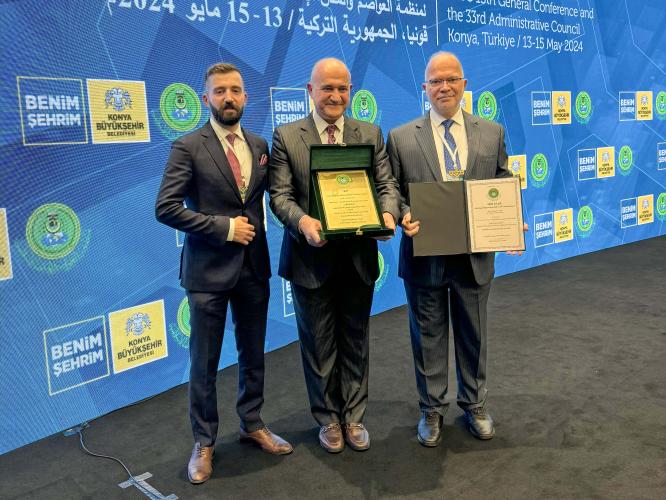Jordanian consultancy firm Bitar Consultants, Architects, Engineers & Project Managers wins first place in the OICC - Organization of Islamic Capitals and Cities Award for its project to revitalize the historic center of Salt.
During the 15th General Conference of the Organization of Islamic Capitals and Cities, held in Konya, Turkey, from May 13 to 15, His Excellency the Secretary-General of the Organization of Islamic Capitals and Cities, Engineer Omar Abdullah Qadi, accompanied by His Excellency Mr. Uğur Ibrahim Altay, Mayor of Konya, awarded Engineer Nemer Bitar, representing Bitar Consultants, the distinguished Jordanian consulting office, the first-place award in the field of architecture for Al Salt urban regeneration project.
This award is given to the most distinguished project among the technical projects and municipal services that serve the vision of developing municipal work, working to ensure its sustainability, and increasing the income generated by them for local communities and municipalities. The award was presented during the opening ceremony of the 15th General Conference of the Organization, along with several other awards for authorship in the fields of engineering, environmental, and municipal sciences, with which the Organization is concerned. The Organization of Islamic Capitals and Cities is an international, non-governmental, non-profit organization founded in 1400 AH (1980 AD) as an associate member of the Organization of the Islamic Conference (OICC). Its members are the capitals and cities of Islamic countries worldwide.
The objectives of these awards include supporting the organization's efforts to preserve the identity and heritage of Islamic capitals and cities and to promote sustainable development therein. The organization also aims to encourage municipalities, owners, architects and urban designers, environmental experts, authors, experts, contractors, and traditional craftspeople to pursue the approach of preserving the identity and heritage of Islamic capitals and cities.
The winning project is the "Revitalization of the Historic Center of Salt," a Ministry of Tourism and Antiquities project funded by the World Bank and implemented by local companies in 2010. This project, among other factors, contributed significantly to Salt's inclusion on UNESCO's World Heritage List in 2021. The Greater Amman Municipality submitted the nomination file for this project, as a member of the Organization of Islamic Capitals and Cities.
Project Link: https://bitarconsultants.com/projects/heritage-tourism/urban-regeneration-project-urban-core-al-salt
The Greater Salt Municipality also supported the nomination file by contributing to the preparation of the document's literature. The project included the rehabilitation of the urban space of Al-Ain Square, the main square in the city of Salt. Until recently, its features were blurred, and three modern government buildings had encroached on its space, significantly contrasting with the city's architectural and urban heritage. The project included structural rehabilitation and architectural restoration of the buildings surrounding the square, particularly the Great Mosque of Salt, which dates back to the Abbasid, Ayyubid, and Ottoman eras. It also included a group of surrounding residential complexes: the Saket Complex, the Khatib Complex, the Sukkar Complex, and the Abu Sarhad Building, adjacent to the Abu Jaber Building.
The building was previously rehabilitated with a Japanese grant and converted into the city's popular life museum. The mosque building required comprehensive rehabilitation, having been rebuilt in the 1960s on the ruins of the historic building, but in a manner that contradicted the city's unique architectural style and distinctive heritage architectural fabric. The project resulted in an increase in the mosque's prayer space capacity by more than 1,000 square meters after the rehabilitation. The project has breathed new life into the heritage buildings opposite the mosque, many of which were abandoned and dilapidated. This work has been done through structural reinforcement, preserving their heritage architectural envelope, and proposing new functions that serve the city's tourism product.
Al-Ain Square, historically the city's vital commercial center, lies between the slopes of Jabal al-Qalaa and Jabal al-Jadaa, stretching approximately 120 meters from the top of Wadi al-Karad down to the site of the main historical spring in front of Darat Abu Jaber. This spring served as a gathering place for water seekers, as it was divided into three springs, accessed through three corridors below ground level. It was divided into three sections: one for men, one for women, and one for watering livestock. The attempt was made to restore the memory of the place through symbolic rehabilitation, introducing water features and waterfalls that adorn the square and add splendor and vitality. The project remains underutilized to date, requiring further attention in management and operations to achieve long-term sustainability.
Finally, it should be noted that this project represents a successful experiment and a milestone at the national, Arab, and Islamic levels. This motivates decision-making bodies to work to replicate this distinguished experience, which was honored and highlighted by the Organization of Islamic Capitals and Cities, to other urban centers and historic city centers in the Hashemite Kingdom of Jordan.

